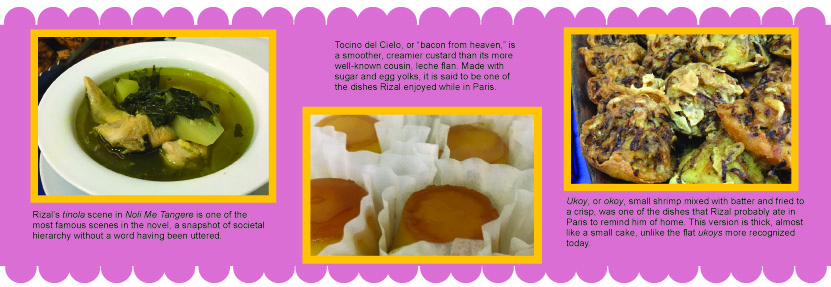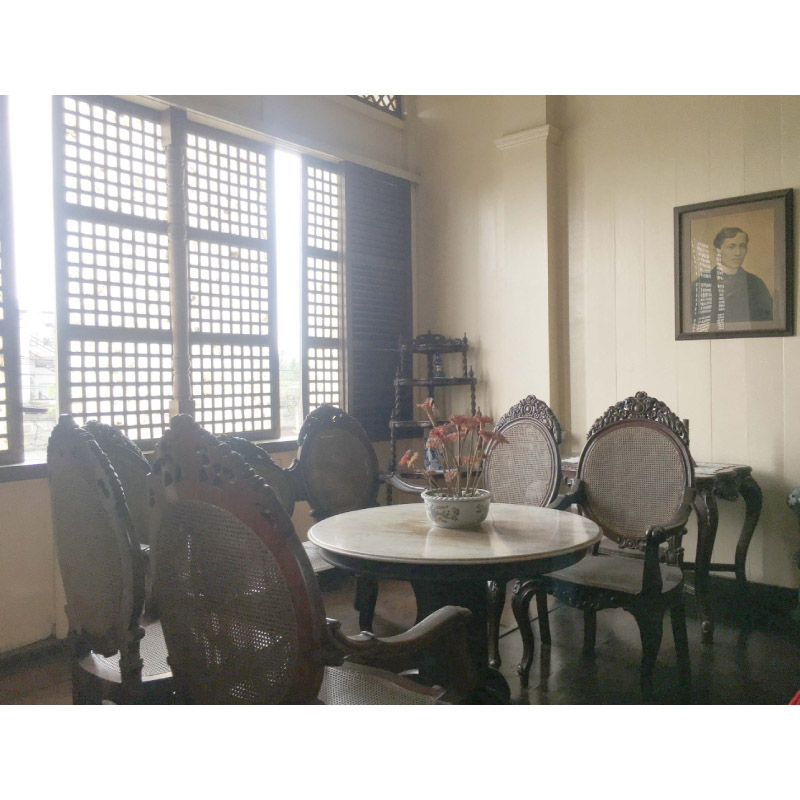
‘Jose Rizal’ and ‘food’ are not words most people would normally associate with each other. And yet food plays a big part in Rizal’s novels, as well as in his life.
The Rizal Shrine in Calamba, Laguna, is a replica of the Rizal ancestral house, where the national hero was born and lived until he left for Ateneo De Manila at 9 years old.
The original house was destroyed during World War II and was restored by an Executive Order under President Elpidio Quirino “with funds mainly contributed by the school children (sic) of the Philippines.”
The current structure was designed by architect Juan F. Nakpil and was inaugurated in 1950.

The two-storey stone house has figures of young Rizal and his mother reading a book on the first floor, as well as photos and memorabilia from different times of the hero’s life, while the second floor is constructed to resemble the Rizals’ house – how it must have looked like when the family was living there.
The nine Rizal girls shared a room and the two boys another. A mabolo tree stands outside the house. Rizal is said to have loved mabolo fruit, and would eat one during his daily morning walk whenever it was in season.
It was here that the Culinary Historians of the Philippines held a Rizal-inspired feast. The food was chosen based on their relation to Rizal – either the dishes were mentioned in his novels or he had eaten them at significant points of his life.
The buffet was prepared by Chef Dino Datu, from whose speech the following notes were taken.
There was dinilawan na hito at alagao, fish cooked in turmeric, of which “Rizal, in his novel Noli Me Tangere, shows his knowledge of local fish in Laguna and the corresponding preparations ideal for each,” Chef Dino said. “The ayungin is good for the sinigan; leave the bia for the escabeche; the dalag and the buan buan for pesa… and so on.’”
There was also miki bihon, a favorite of Rizal’s, as well as a nod to Rizal’s Chinese ancestry.
“Rizal is believed to be of Chinese descent. Mercado, their family name, was derived from their grandfather, Domingo Lam Co, being a merchant at the market, or Mercado. Josephine Bracken even (made) noodles from scratch in Dapitan when they didn’t have noodles for pancit. As Rizal wrote, ‘Miss B made a kind of long macaroni noodles out of flour and eggs, which serves the purpose,’” Chef Dino said.
Although a lunch buffet, common snack time treats were also present at the table. Lumpia, ukoy, ginataan, and tocino del cielo – dishes that Rizal probably ate when he was in Europe.
“Some of the food was prepared by Doña Juliana Pardo de Tavera in Paris in the late 1880s when Rizal stayed there. Rizal and his friends often met during the week at the homes of prominent Filipinos. Sundays were usually spent at the Pardo de Taveras,” Chef Dino said, adding that the recipes were sent to Doña Juliana from the Philippines, and are currently housed in a collection at the Ateneo.

Of course, no Rizal-themed feast would be complete without native chicken tinola, the dish that is perhaps most linked to the national hero.
“In Noli Me Tangere, tinola features as the dish served at Kapitan Tiago’s house, where Padre Damaso and Crisostomo Ibarra are both guests. Father gets the neck while Ibarra gets the breast and gizzard, the most prized parts. Of course, Padre Damaso throws a fit and slams his spoon, feeling slighted because he didn’t get the prime parts. Of course, Rizal’s tinola used squash instead of the more common papaya. The reason behind this, as rumor has it, is that kalabasa is better for the eyes,” Chef Dino explained.
The life of Jose Rizal continues to capture the Filipino imagination, and the topics explored in his novels still ring uncomfortably true up to today. Not everyone can take a trip to Laguna to visit the house where Rizal grew up, but anyone can cook a pot of tinola at home.
By eating this beloved dish, as well as the other dishes listed, one can bring oneself closer to the memory of Rizal. Food isn’t just about filling a hungry belly. When taken in a historical context, especially when paired with original recipes, it can be a very direct link to the past and the people that populated it.
